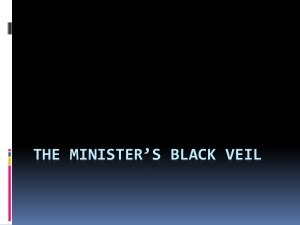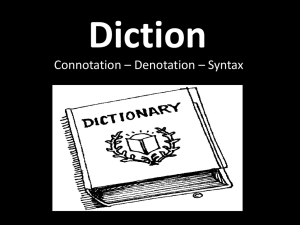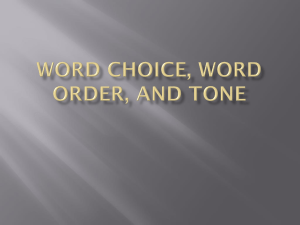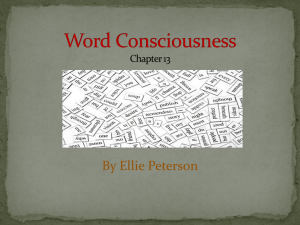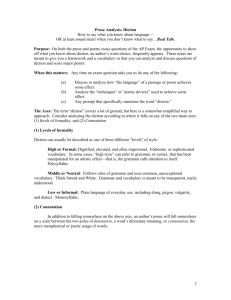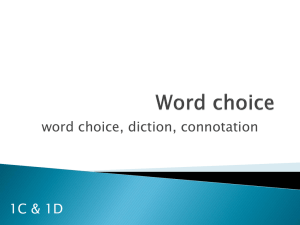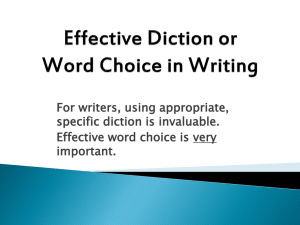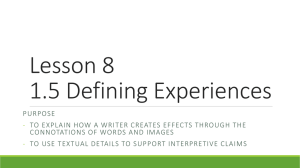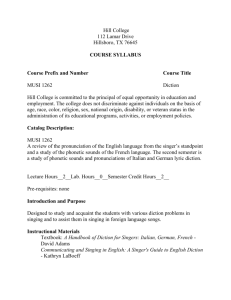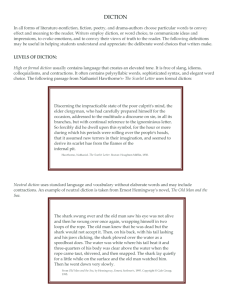Diction
advertisement
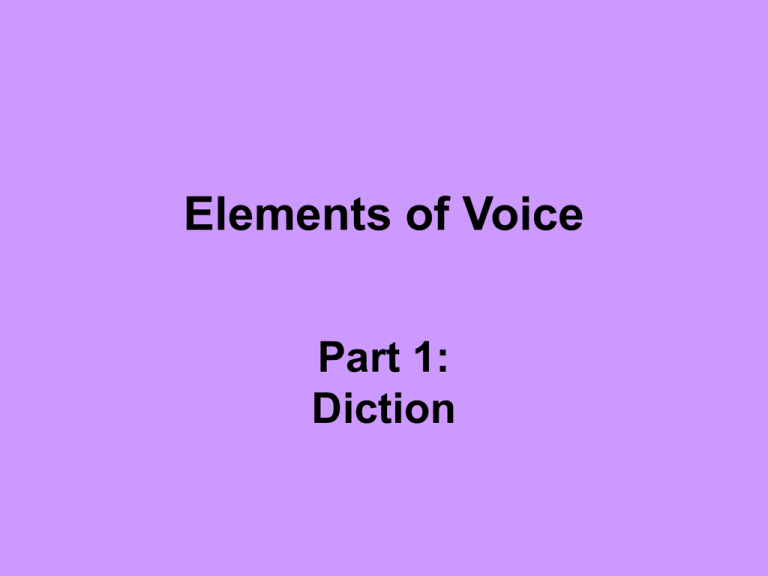
Elements of Voice Part 1: Diction Words • The basic tools of a writer • They create color and texture • They reflect and to determine the formality of the piece • They shape the readers’ perceptions • Clear, concrete and exact words convey an author’s voice Diction • The author’s choice of words • Directs a writer’s vision and steers a reader’s thought Alternative Diction • Instead of: – The coat is torn – The U.S. wants revenge – The door shuts – She ate the cookie – He looked around the room • Try: – The coat is tattered – The U.S. thirsts for revenge – The door thuds – She nibbled the cookie – He glanced around the room Diction and Rhetoric • Diction is dependent on the audience, the purpose, and the topic • When one of the components of the rhetoric triangle changes, the diction must be reevaluated, as well. Rhetoric Purpose • Purpose: – Inform – entertain • Diction: – Straightforward – Ironic, playful, unexpected Diction and Occasion Formality influences appropriate diction • Occasion: – Scholarly writing and serious prose/poetry – Expository essays, newspaper, editorials and works of fiction – Historical or regional dialect and/or specific mood/character development • Diction – Formal – Informal – Colloquial language and slang Diction • Connotation: the meaning suggested by a word • Denotation: the literal meaning of the word Connotative Power • The writer’s ability to produce a strong reaction in the reader lies in finding words with the right connotation. Connotation • • • • The character had a slender figure. The character had a thin figure. The character had an emaciated figure. The character had a skinny figure. Connotation • The man liked the woman’s company. • The man enjoyed the woman’s company. • The man desired the woman’s company. Connotation • The big sandwich sat on the table. • The robust sandwich waited on the table. • The enormous sandwich rested on the table Diction and Originality • Strong writers use words in surprising or unusual ways to make a reader rethink an idea or re-examine meaning. • This often happens by selecting words that have multiple meanings and/or by using words in a context they are not often associated—breaking the denotative mold. Practice Write it down: “As I watched, the sun broke weakly through, brightened the rich red of the fawns, and kindled their white spots.” --E.B. White, “Twins,” Poems and Sketches of E.B. White Think • What kind of flame does kindled imply? • How does this verb suit the purpose of this sentence? • How would the effect of this sentence change if the verb kindled were changed to ignited. Think • Would the sentence be strengthen or weakened by changing “the sun broke weakly through” to “the sun burst through?” • Explain how this change would impact the use of the word kindled. Apply • Brainstorm a list of action verbs that demonstrate the effects of sunlight (alternatives to broke through, burst through, brightened, etc.) • How do some of these impact the meaning of the poetic line? Practice “The man sighed hugely.” --E. Annie Proulx, The Shipping News • What does it mean to sigh hugely? • How would the meaning of the sentence change if we rewrote it as: The man sighed loudly? • Fill in the blank with an adverb: The man coughed __________. Your adverb should make the cough express an attitude (contempt, desperation, propriety, etc.) Don’t state the attitude, let the adverb imply it. Consider Newts are the most common of salamanders. Their skin is a lighted green, like water in a sunlit pond, and rows of very bright red dots line their backs. They have gills as larvae; as they grow they turn a luminescent red, lose their gills, and walk out of the water to spend a few years padding around in damp places on the forest floor. Their feet look like fingered baby hands, and they walk in the same leg patterns as all four-footed creatures-dogs, mules, and, for that matter, lesser pandas. ~ Annie Dillard, Pilgrim at Tinker Creek Discuss 1. What is the difference between a lighted green and a light green? Which one to you think creates a more vivid picture? 2. What is the effect of saying fingered baby hands instead of simply baby hands? Apply Compare the neck of each of the animals below to something familiar. Use Dillard’s comparison (Their feet look like fingered baby hands) as a model. Share one of your comparisons with the class and explain the attitude it conveys about the animal. • The elephant’s neck looks like _________ • The gazelle’s neck looks like _______ • The flamingo’s neck looks like _______ Consider This is earthquake Weather! Honor and Hunger Walk lean Together. ~ Langston Hughes, “Today” Discuss 1. What does lean mean in this context? 2. Is lean a verb, an adjective, or both? How does this uncertainty and complexity contribute to the impact of the lines? Apply With a partner, read the poem aloud several times, changing the meaning of lean with your voice. Discuss how you controlled your voice to make the changes.

